Tunneling Magnetoresistance DC Current Transformer for Ion Beam Diagnostics
Abstract
1. Introduction
2. Open Loop MR-Based DCCT
2.1. Overview on MR Sensors
2.2. Noise Analysis of GMR and TMR Sensors
2.3. Open Loop MR-Based DCCT Experimental Results
3. Proposed Closed Loop TMR-Based DCCT
3.1. Closed Loop TMR-Based DCCT Electrical Model and Block Diagram
3.2. Closed Loop TMR-Based DCCT Noise Analysis
3.3. Step Response Simulation Results
4. Experimental Results and Discussion
4.1. Measurement Results
4.2. Discussions and Comparisons
5. Conclusions
Author Contributions
Funding
Institutional Review Board Statement
Informed Consent Statement
Data Availability Statement
Conflicts of Interest
References
- Forck, P. Lecture Notes on Beam Instrumentation and Diagnostics. Available online: https://indico.cern.ch/event/569714/contributions/2303731/attachments/1415057/2166101/juas_script.pdf (accessed on 1 March 2021).
- Ripka, P. Electric current sensors: A review. Meas. Sci. Technol. 2010, 21, 112001. [Google Scholar] [CrossRef]
- Unser, K. Beam Current Transformer with DC to 200 MHz Range. IEEE Trans. Nucl. Sci. 1969, 16, 934–938. [Google Scholar] [CrossRef]
- Yu, H.; Zheng, Q.; Liu, H.; Qu, J. Circular Array of Magnetic Sensors for Current Measurement: Analysis for Error Caused by Position of Conductor. Sensors 2018, 18, 578. [Google Scholar] [CrossRef] [PubMed]
- Tsai, Y.; Chen, K.; Chen, Y.; Chen, N. Multifunctional Coreless Hall-Effect Current Transformer for the Protection and Measurement of Power Systems. IEEE Trans. Instrum. Meas. 2014, 63, 557–565. [Google Scholar] [CrossRef]
- Wang, G.; Lv, Y.; Xiao, H.; Li, L. Design and Test of a Long-Pulse Large Current Sensor With a Hall Probe Installed Inside. IEEE Trans. Appl. Supercond. 2014, 24, 9001804. [Google Scholar]
- Ajbl, A.; Pastre, M.; Kayal, M. A Fully Integrated Hall Sensor Microsystem for Contactless Current Measurement. IEEE Sens. J. 2013, 13, 2271–2278. [Google Scholar] [CrossRef]
- Crescentini, M.; Marchesi, M.; Romani, A.; Tartagni, M.; Andrea Traverso, P. A Broadband On-Chip Sensor Based on Hall Effect for Current Measurements in Smart Power Circuits. IEEE Trans. Instrum. Meas. 2018, 67, 1470–1488. [Google Scholar] [CrossRef]
- Chen, Y.; Huang, Q.; Khawaja, A.H.; Dongsheng, C.; Wu, J. A novel non-invasion magnetic sensor array based measurement method of large current. Measurement 2019, 139, 78–84. [Google Scholar] [CrossRef]
- Chen, K.; Chen, N. A New Method for Power Current Measurement Using a Coreless Hall Effect Current Transformer. IEEE Trans. Instrum. Meas. 2011, 60, 158–169. [Google Scholar] [CrossRef]
- Gao, L.; Chen, F.; Yao, Y.; Xu, D. High-Precision Acceleration Measurement System Based on Tunnel Magneto-Resistance Effect. Sensors 2020, 20, 1117. [Google Scholar] [CrossRef] [PubMed]
- Mușuroi, C.; Oproiu, M.; Volmer, M.; Firastrau, I. High Sensitivity Differential Giant Magnetoresistance (GMR) Based Sensor for Non-Contacting DC/AC Current Measurement. Sensors 2020, 20, 323. [Google Scholar] [CrossRef] [PubMed]
- Murzin, D.; Mapps, D.J.; Levada, K.; Belyaev, V.; Omelyanchik, A.; Panina, L.; Rodionova, V. Ultrasensitive Magnetic Field Sensors for Biomedical Applications. Sensors 2020, 20, 1569. [Google Scholar] [CrossRef] [PubMed]
- Soliman, E.; Hofmann, K.; Reeg, H.; Schwickert, M. Sensor Studies for DC Current Transformer Application. In Proceedings of the International Beam Instrumentation Conference (IBIC), Monterey, CA, USA, 14–18 September 2014. [Google Scholar]
- Haepe, M.; Becker, W.; Ricken, W.; Peters, A.; Reeg, H.; Kowina, P. High Dynamic Magnetic Beam Current Measurements by Means of optimised Magneto-Resistance (MR) Sensor Engineering. In Proceedings of the 7th European workshop on Beam Diagnostics and Instrumentation for Particle Accelerators (DIPAC), Lyon, France, 6–8 June 2005. [Google Scholar]
- Soliman, E.; Hofmann, K.; Reeg, H.; Schwickert, M. Noise study of open-loop direct current-current transformer using magneto-resistance sensors. In Proceedings of the IEEE Sensors Applications Symposium (SAS), Catania, Italy, 20–22 April 2016. [Google Scholar]
- Schwickert, M.; Kurian, F.; Sieber, T.; Reeg, H.; Neubert, R.; Seidel, P.; Hofmann, K.; Soliman, E. Status of Beam Current Transformer Developments for FAIR. In Proceedings of the International Beam Instrumentation Conference (IBIC), Barcelona, Spain, 11–15 September 2016. [Google Scholar]
- Yang, X.; Liu, H.; Wang, Y.; Wang, Y.; Dong, G.; Zhao, Z. A Giant Magneto Resistive (GMR) Effect Based Current Sensor with a Toroidal Magnetic Core as Flux Concentrator and Closed-Loop Configuration. IEEE Trans. Appl. Supercond. 2014, 24, 1–5. [Google Scholar]
- Li, Z.; Dixon, S. A Closed-Loop Operation to Improve GMR Sensor Accuracy. IEEE Sens. J. 2016, 16, 6003–6007. [Google Scholar] [CrossRef]
- Andreev, S.; Dimitrova, P. Anisotropic-magnetoresistance integrated sensors. J. Optoelectron. Adv. Mater. 2005, 7, 199–206. [Google Scholar]
- Lei, Z.Q.; Li, G.J.; Egelhoff, W.F.; Lai, P.T.; Pong, P.W.T. Review of Noise Sources in Magnetic Tunnel Junction Sensors. IEEE Trans. Magn. 2011, 47, 602–612. [Google Scholar] [CrossRef]
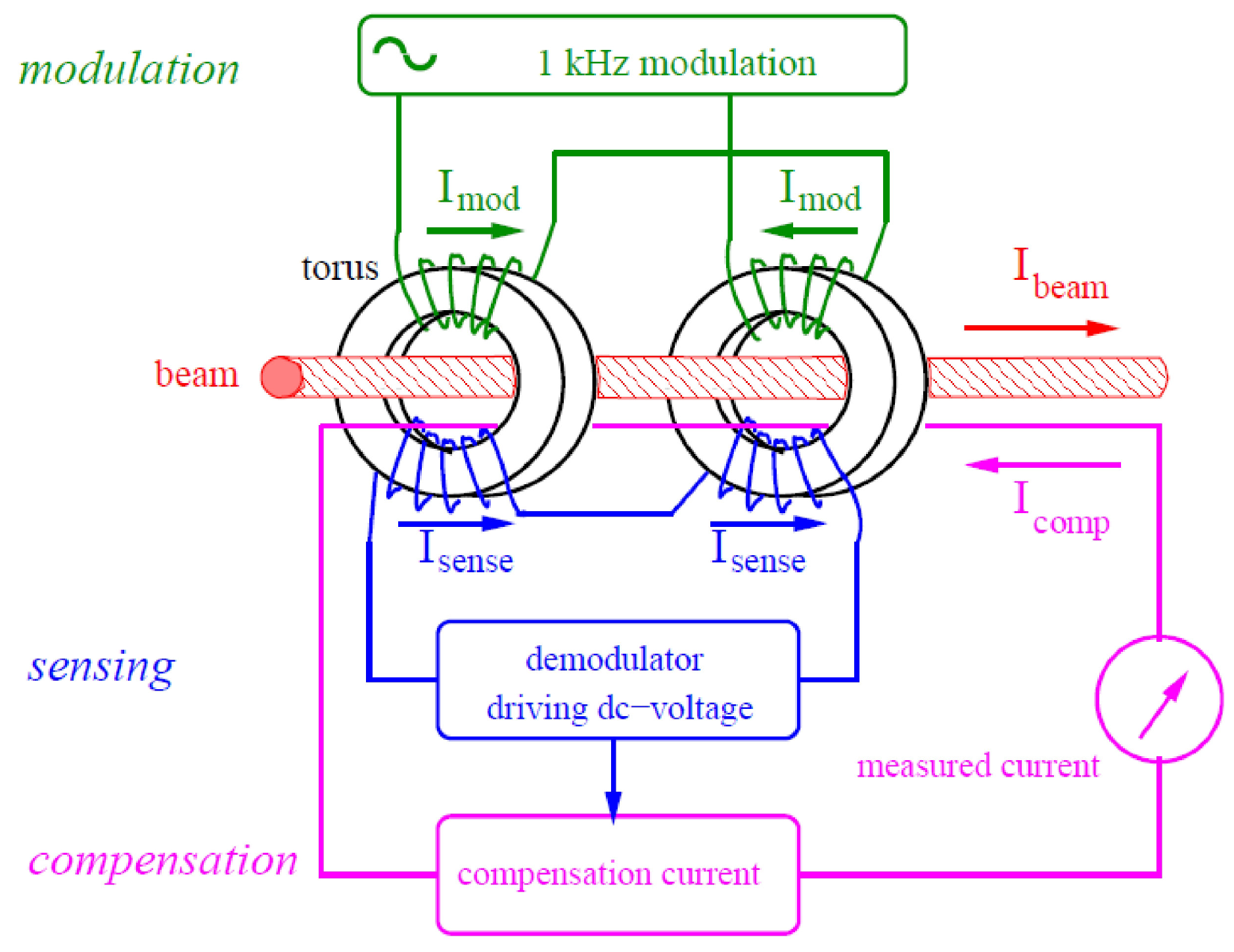



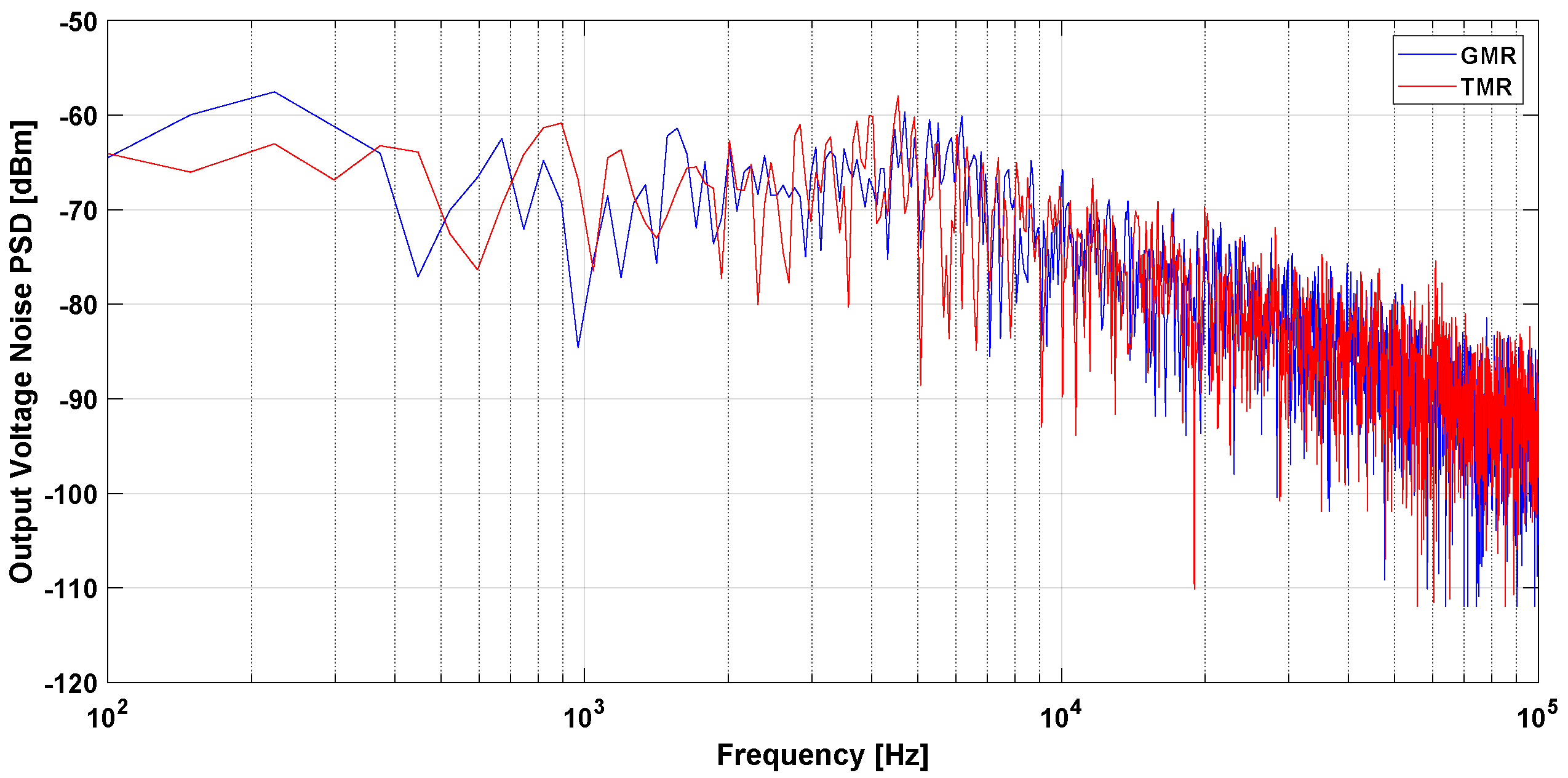
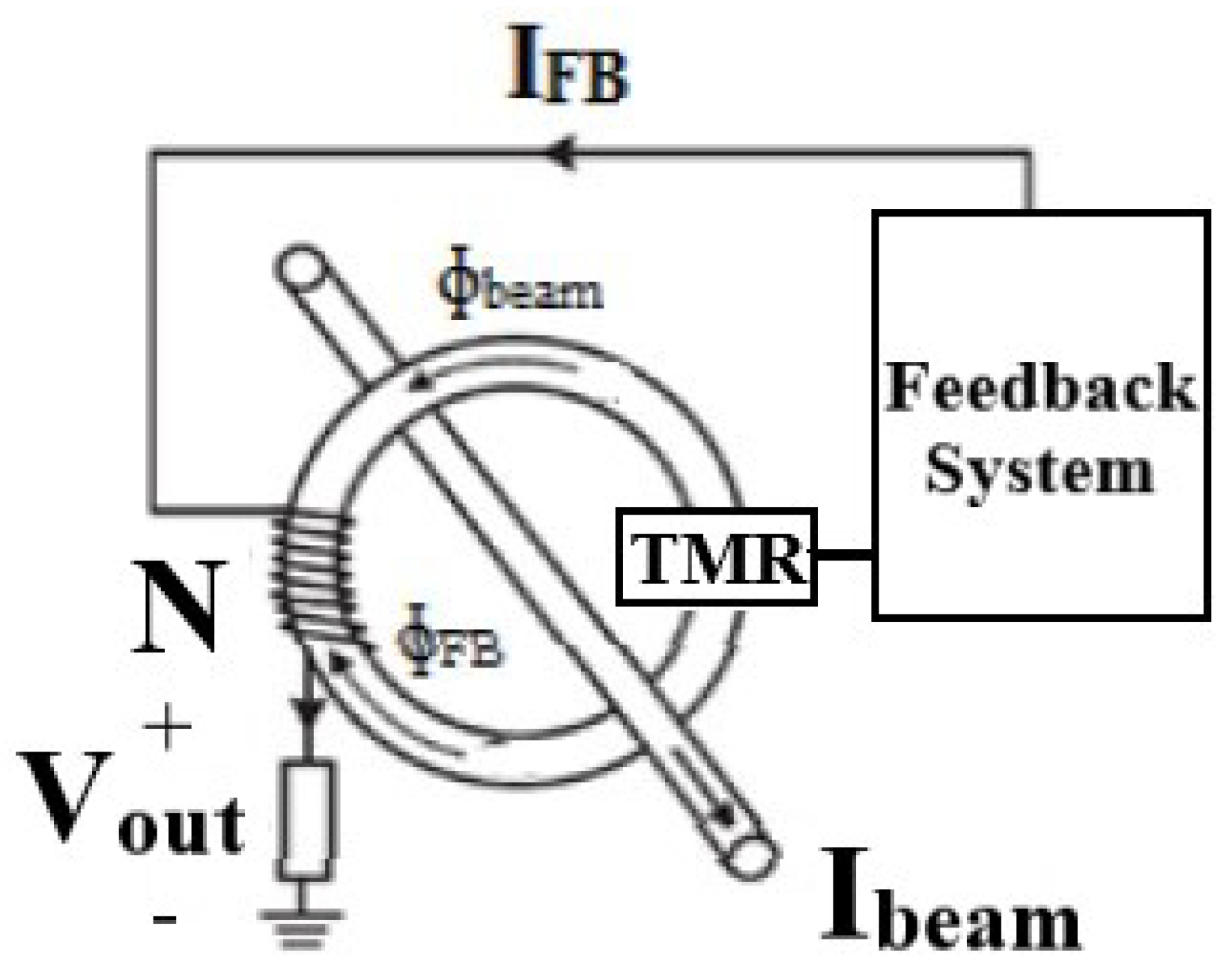


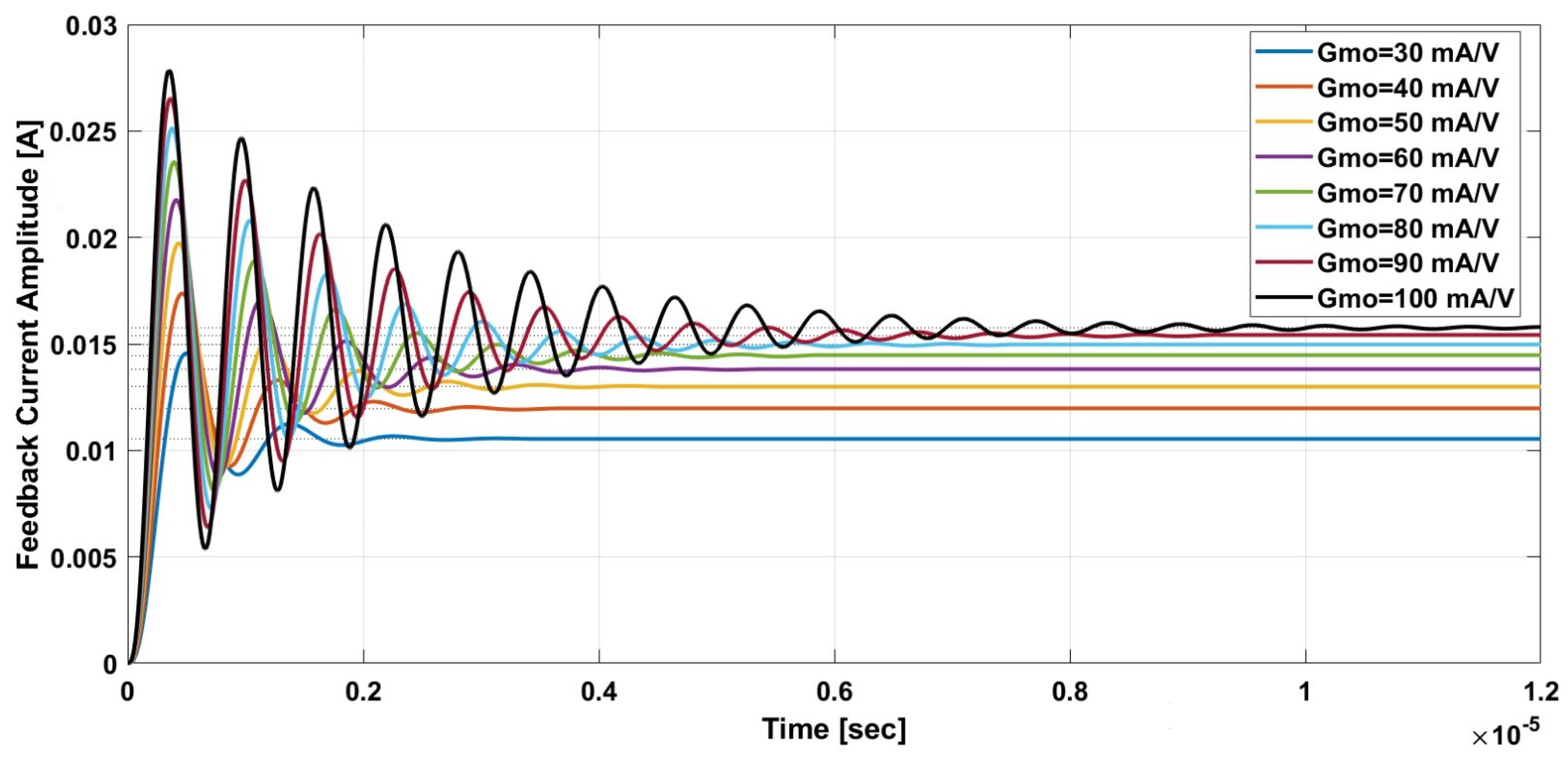


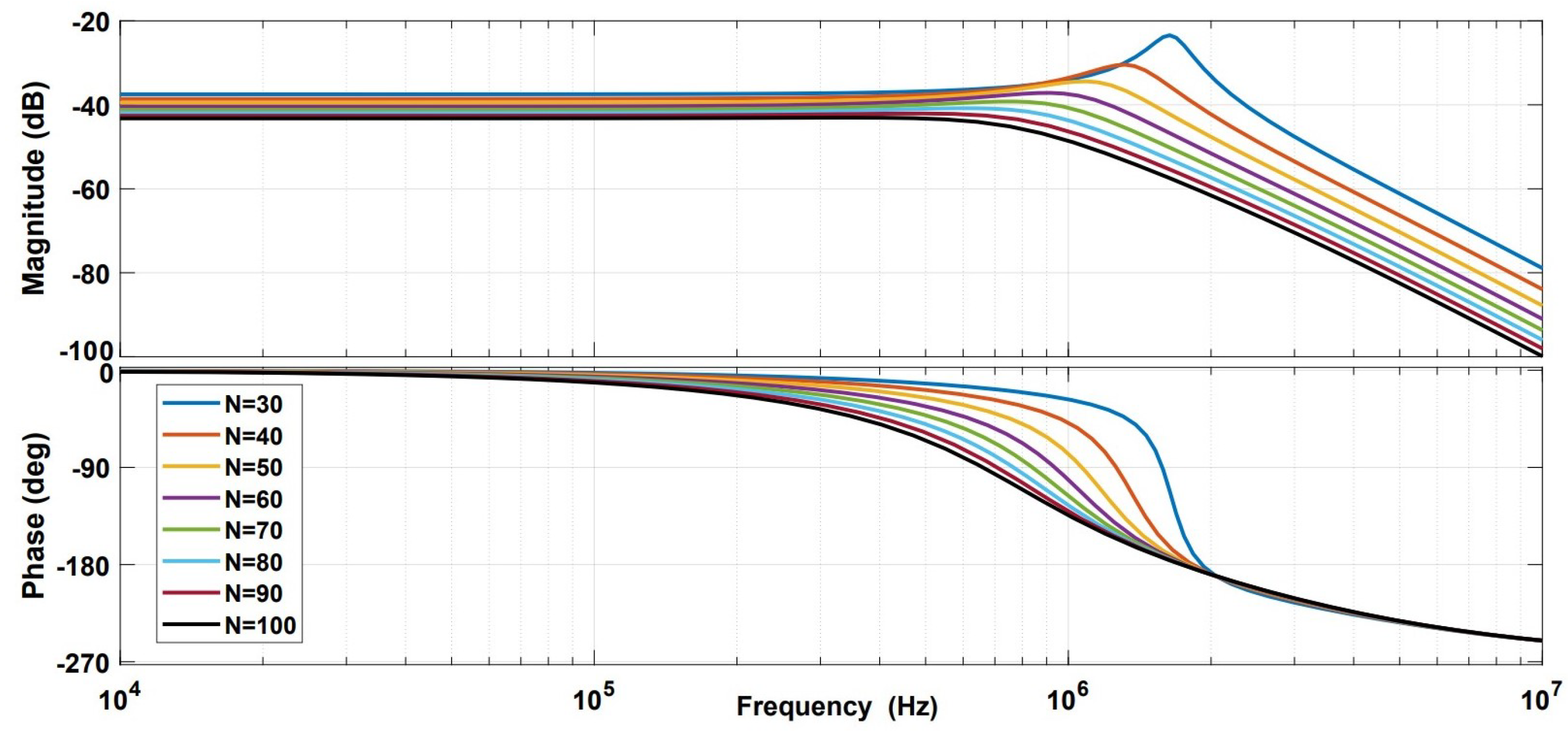
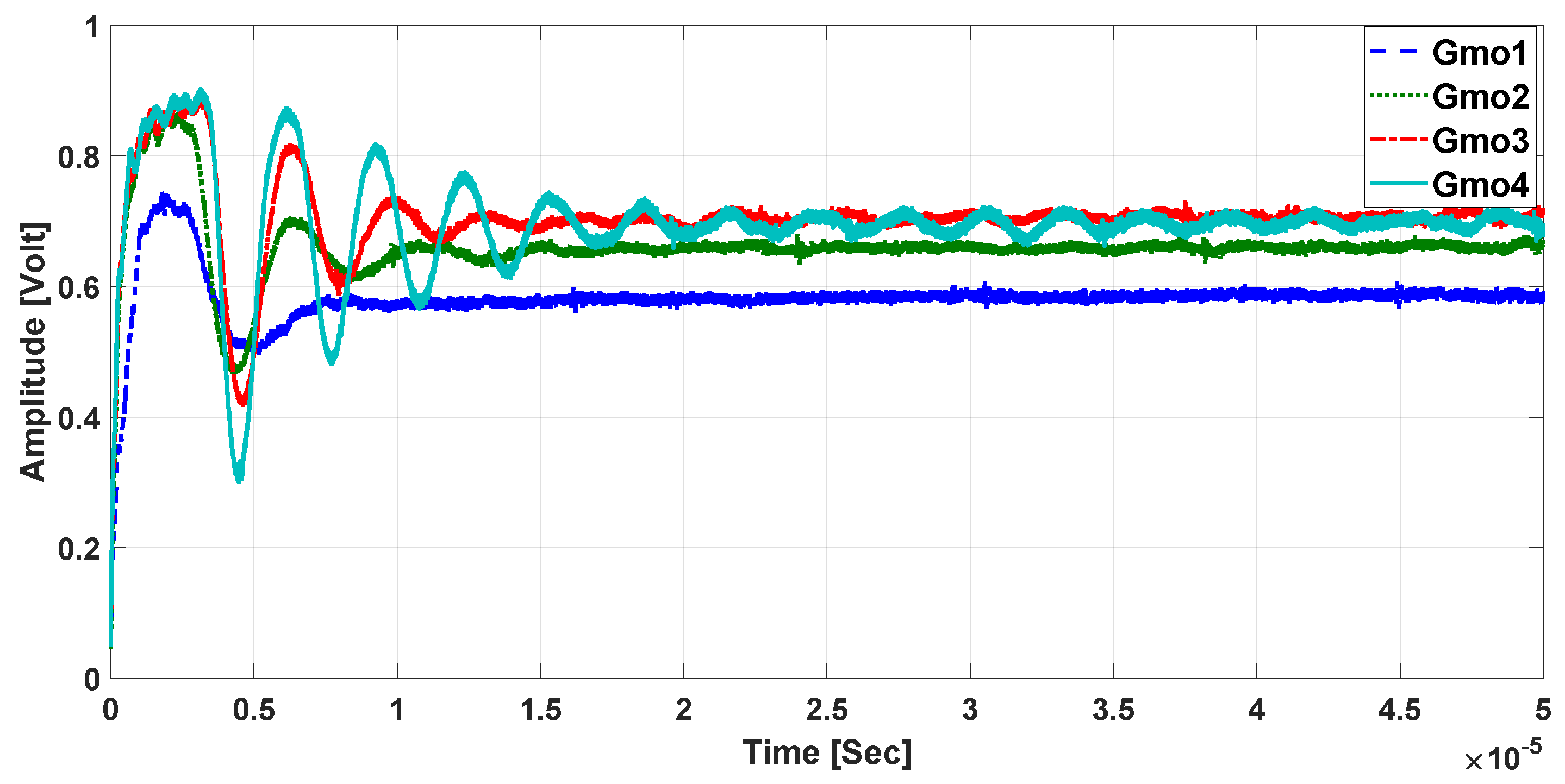
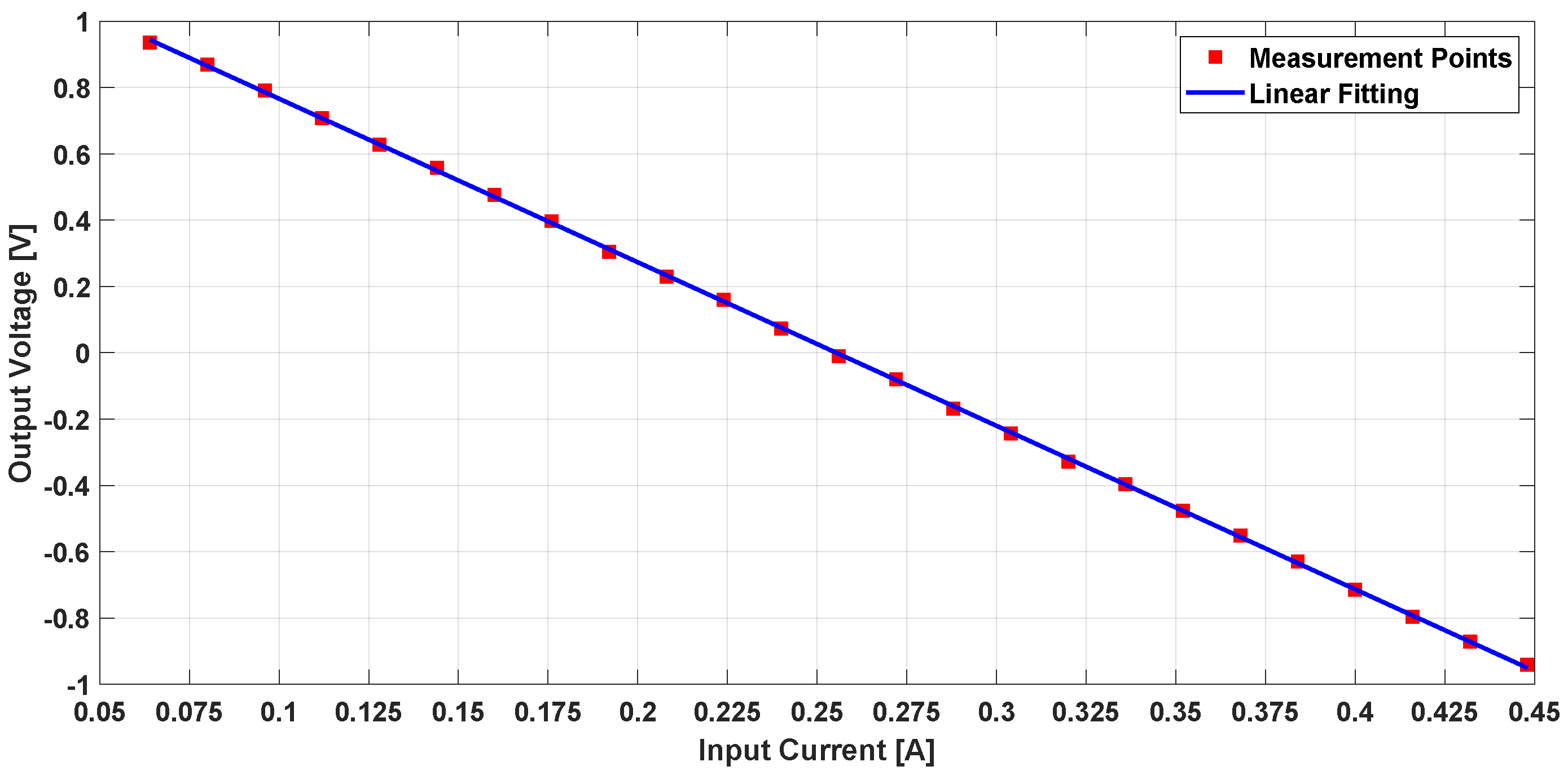
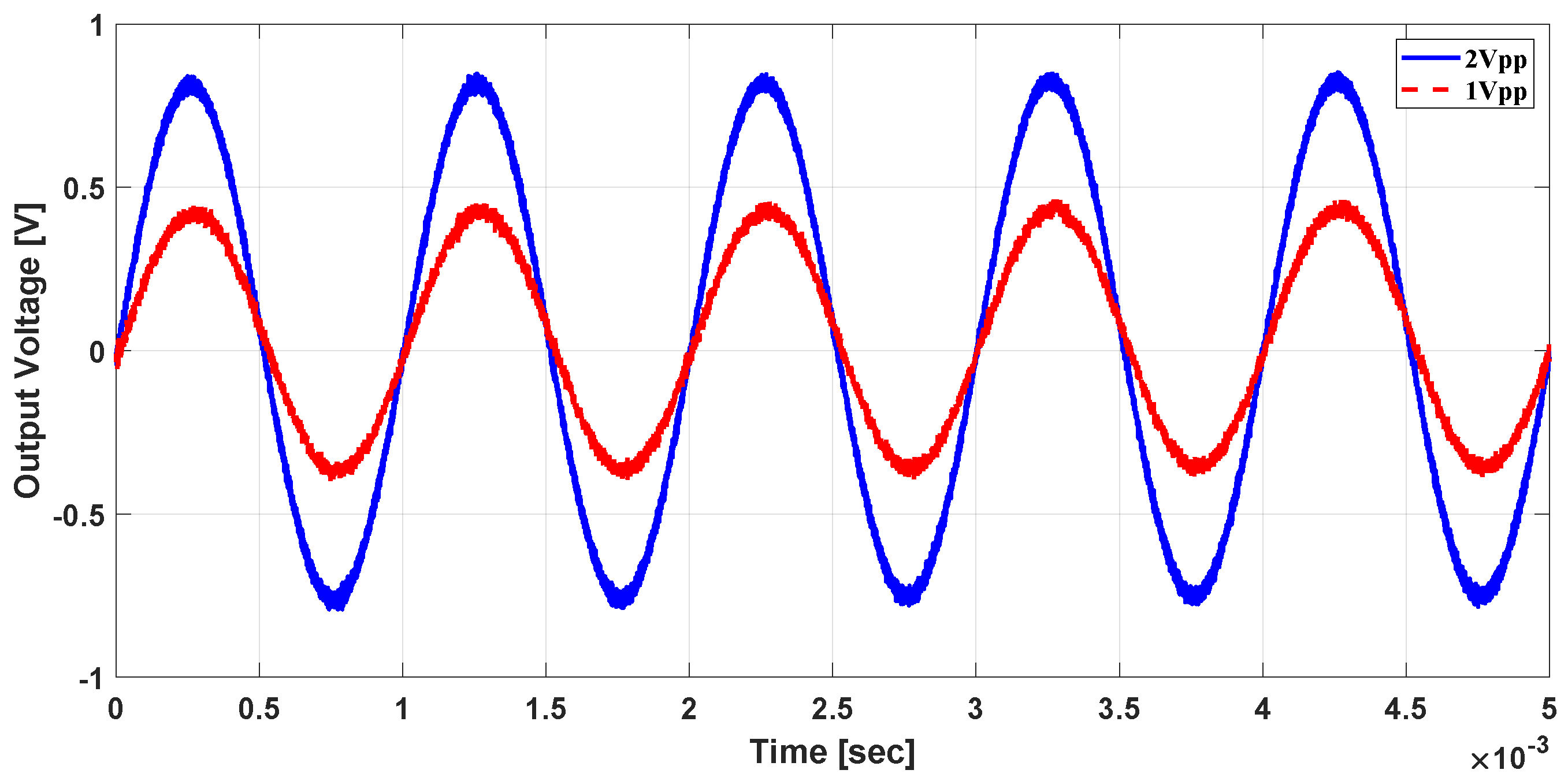
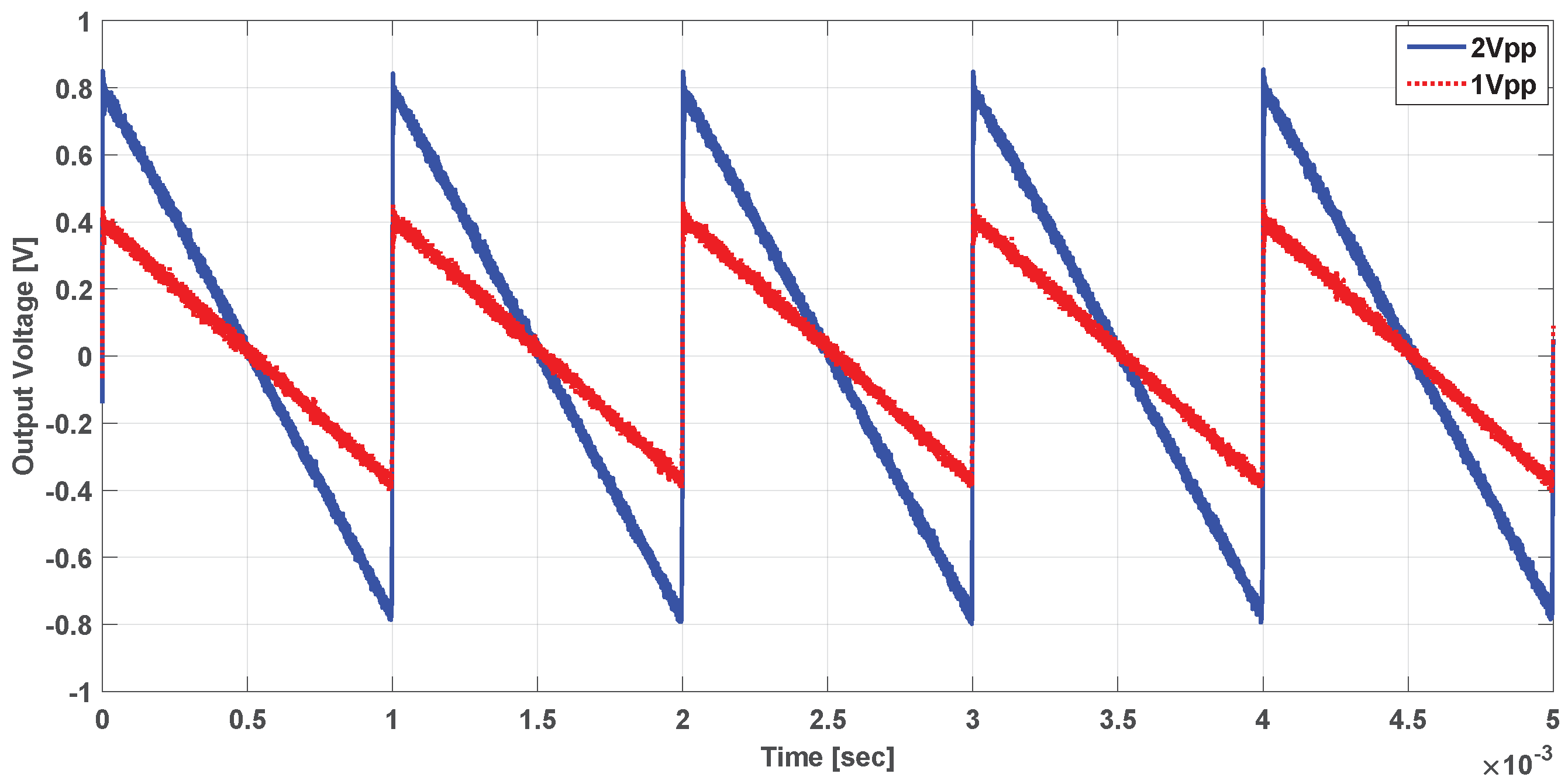
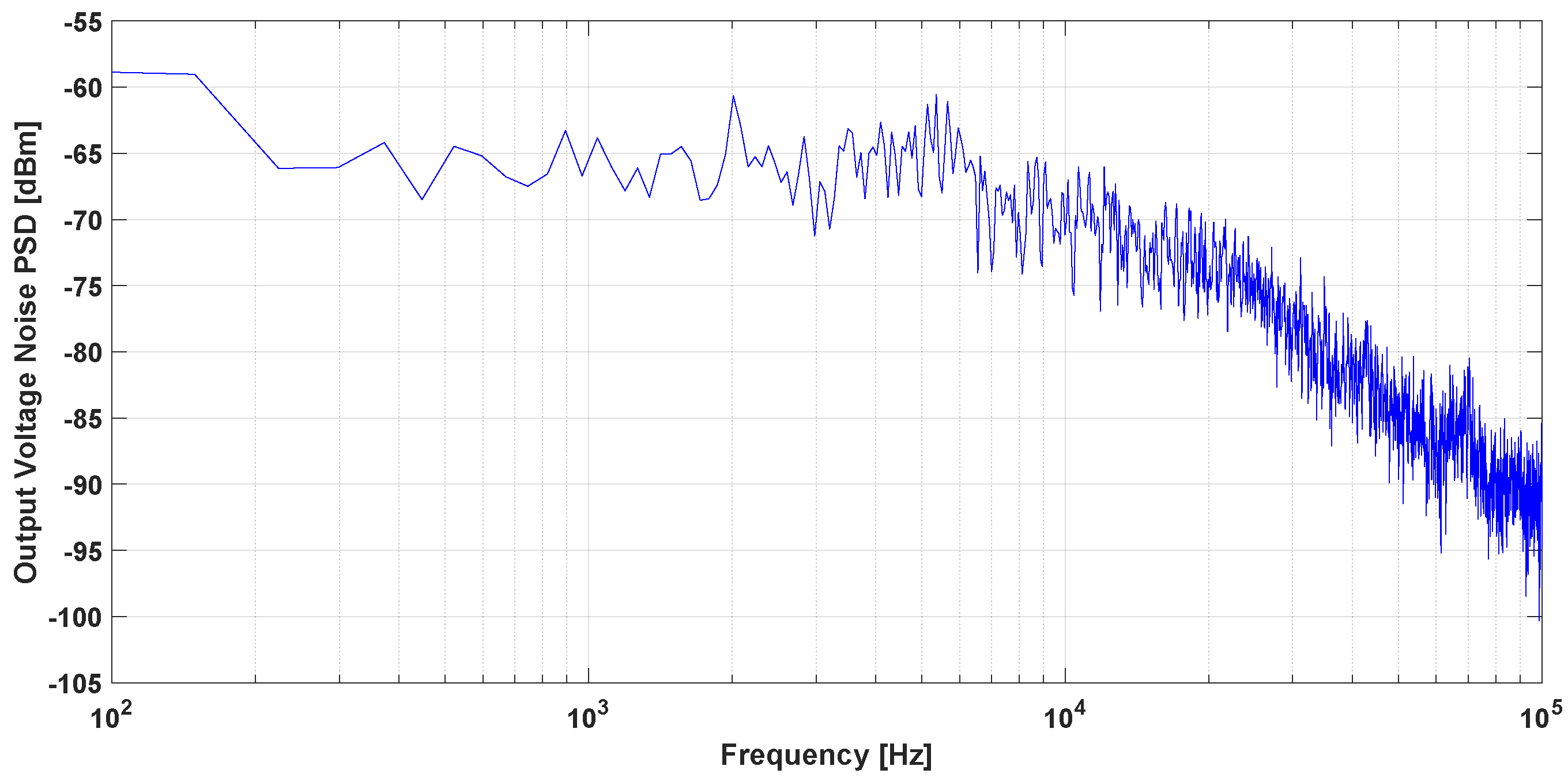
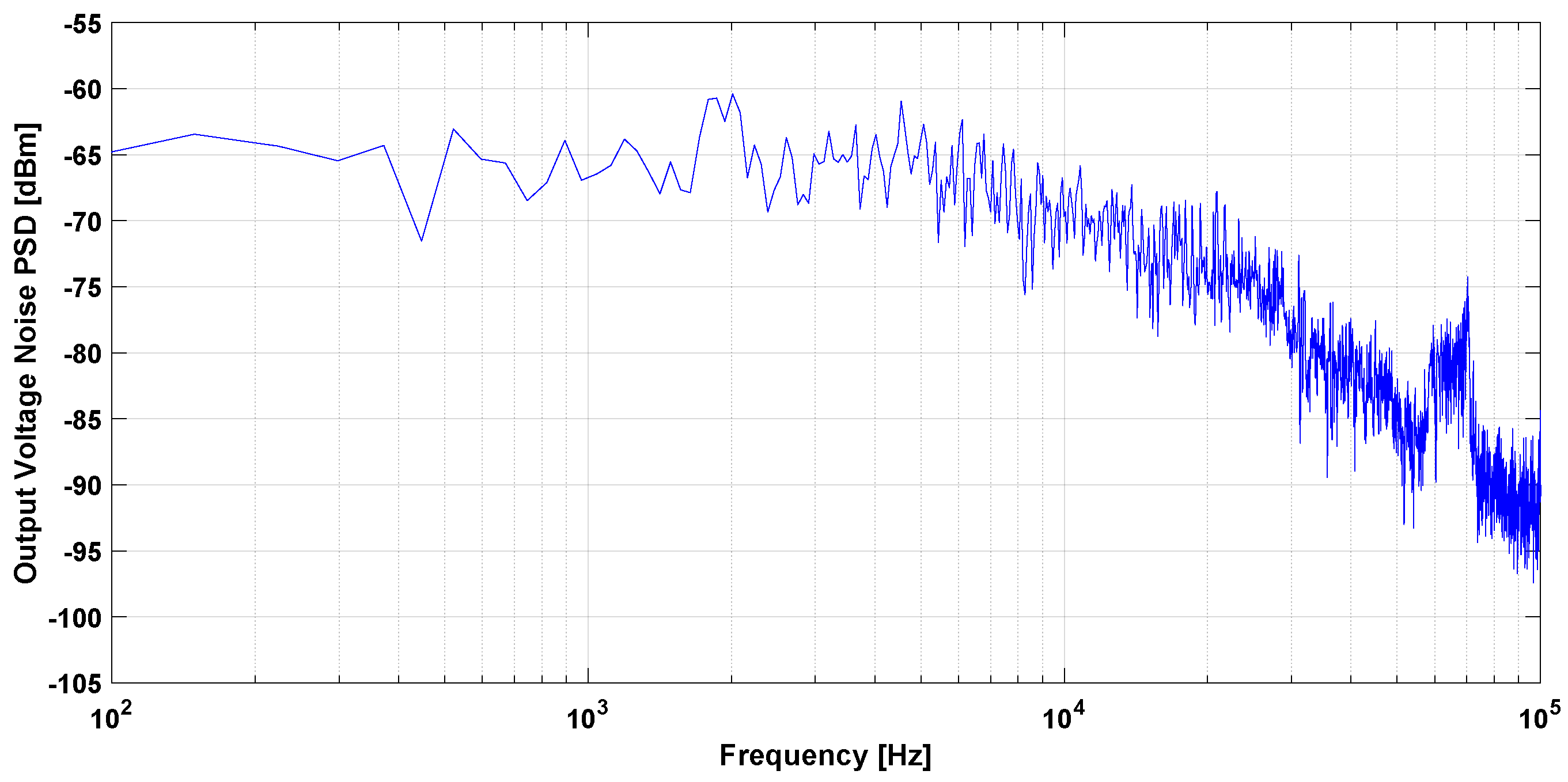
| Parameter | Value @1 Hz | Value @1 kHz |
|---|---|---|
| GMR Sensitivity | 3.14 V/mT | 3.14 V/mT |
| TMR Sensitivity | 12.47 V/mT | 12.47 V/mT |
| GMR-DCCT DC Gain | 0.396 V/A | 0.396 V/A |
| TMR-DCCT DC Gain | 1.56 V/A | 1.56 V/A |
| GMR-DCCT Output Referred Noise | 125.7 μV/ | 22.4 μV/ |
| GMR Detectivity Factor | 40 nT/ | 7.13 nT/ |
| TMR-DCCT Output Referred Noise | 200 μV/ | 35 μV/ |
| TMR Detectivity Factor | 16.04 nT/ | 2.8 nT/ |
| GMR-DCCT Min. Detectable current | 317.4 μA/ | 56.6 μA/ |
| TMR-DCCT Min. Detectable current | 128.2 μA/ | 22.4 μA/ |
| Parameter | Value @1 Hz |
|---|---|
| DC Gain | −4.93 V/A |
| Settling Time | <15 μs |
| Output Referred Noise (Single OTA) | 141.1 μV/ |
| Output Referred Noise (Four OTAs) | 50 μV/ |
| Min. Detectable current (Single OTAs) | 28.6 μA/ |
| Min. Detectable current (Four OTAs) | 10.14 μA/ |
Publisher’s Note: MDPI stays neutral with regard to jurisdictional claims in published maps and institutional affiliations. |
© 2021 by the authors. Licensee MDPI, Basel, Switzerland. This article is an open access article distributed under the terms and conditions of the Creative Commons Attribution (CC BY) license (https://creativecommons.org/licenses/by/4.0/).
Share and Cite
Azab, E.; Hegazy, Y.G.; Reeg, H.; Schwickert, M.; Hofmann, K. Tunneling Magnetoresistance DC Current Transformer for Ion Beam Diagnostics. Sensors 2021, 21, 3043. https://doi.org/10.3390/s21093043
Azab E, Hegazy YG, Reeg H, Schwickert M, Hofmann K. Tunneling Magnetoresistance DC Current Transformer for Ion Beam Diagnostics. Sensors. 2021; 21(9):3043. https://doi.org/10.3390/s21093043
Chicago/Turabian StyleAzab, Eman, Yasser G. Hegazy, Hansjoerg Reeg, Marcus Schwickert, and Klaus Hofmann. 2021. "Tunneling Magnetoresistance DC Current Transformer for Ion Beam Diagnostics" Sensors 21, no. 9: 3043. https://doi.org/10.3390/s21093043
APA StyleAzab, E., Hegazy, Y. G., Reeg, H., Schwickert, M., & Hofmann, K. (2021). Tunneling Magnetoresistance DC Current Transformer for Ion Beam Diagnostics. Sensors, 21(9), 3043. https://doi.org/10.3390/s21093043








